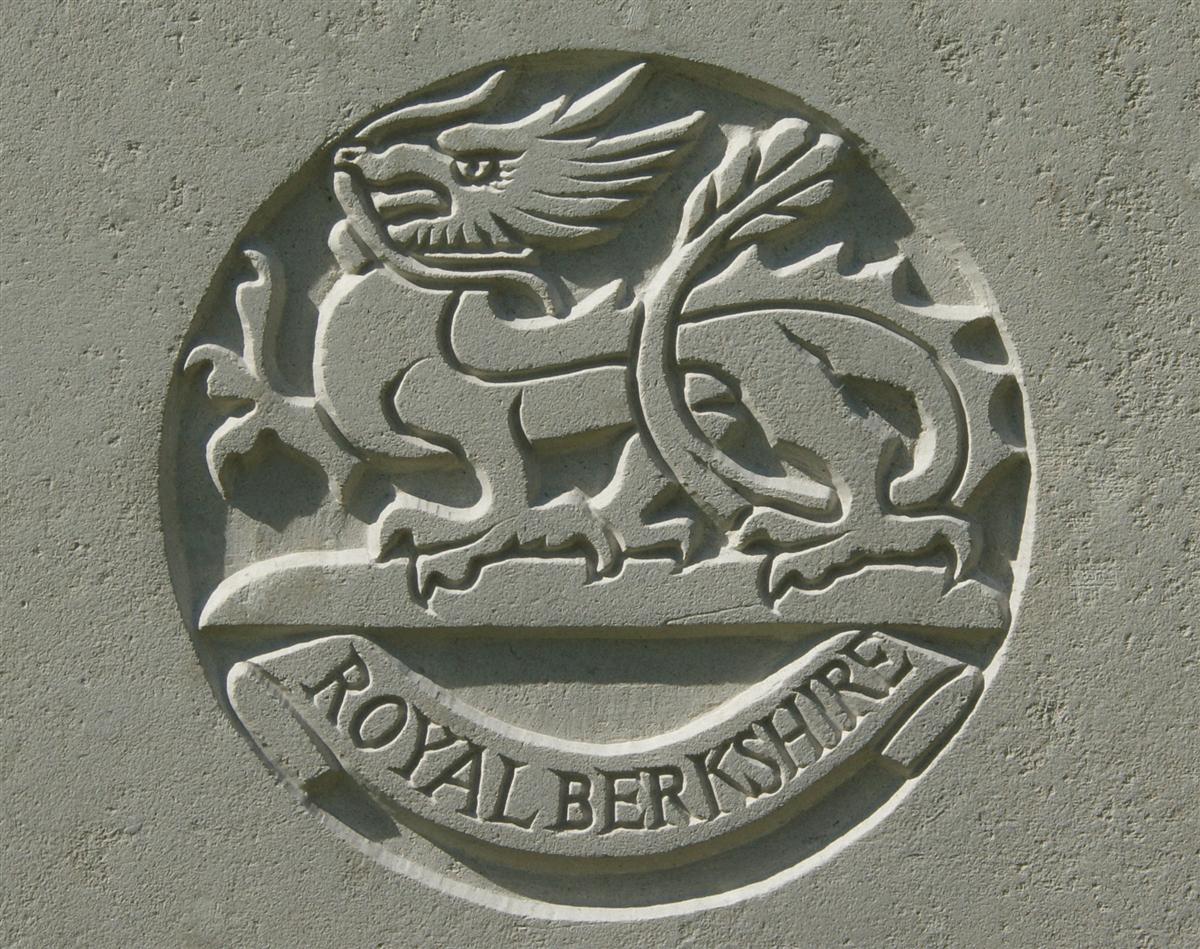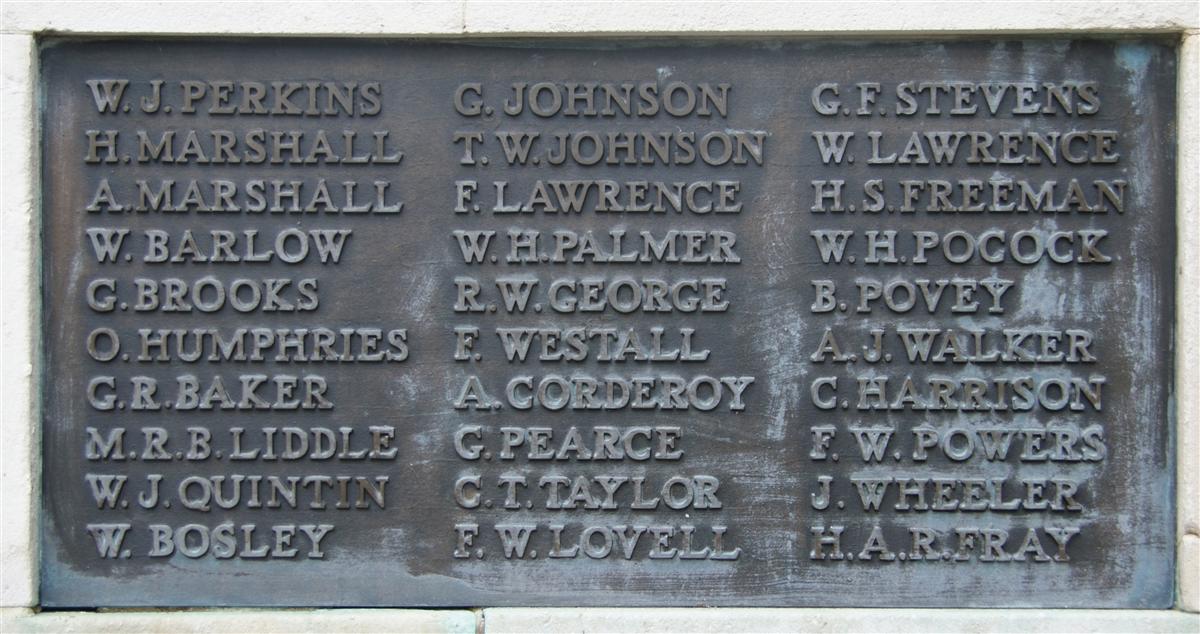Francis William Lovell
Private 19953 Francis William Lovell, 2nd Battalion, Royal Berkshire Regiment.

The regimental badge of the Berkshire Regiment, as used on CWGC headstones. |
Frank was born in early 1894 in Newbury. His father, Frederick Lovell, was a timber carter and moved around, appearing in different places at census times.
Frederick himself was born in Silverstone, Northamptonshire; in 1891, aged 22, he was living with his brother Ernest in Thrupp, Oxfordshire. His wife, Emily Mary H Boyes was born in Bletchingdon, Oxfordshire, where they married in late 1892 - probably in Bletchingdon. Frank was their eldest child and the only one born in Newbury, the remaining three were born in Kidlington, Oxfordshire between 1895 and 1900. By 1901 they had moved to Faringdon, Berkshire (now Oxfordshire). By the time Frank died in 1916 they were back in Newbury at Ham-cottages, London Road. At some point in 1917/18 they moved again, to Tyle Mills Cottages in Sulhampstead.
Most Great War servicemen fall into four general categories: (1) Pre-war regulars, reserves and territorials; (2) Kitchener volunteers - the enthusiastic early volunteers; (3) Derby Scheme volunteers; and (4) Conscripts - following the introduction of conscription in January 1916. Frank was a Derby Scheme man, enlisting on 6 December 1915. By late 1915 the stream of enthusiastic recruits had dried up and conscription was becoming ever more likely. In a last attempt to attract more volunteers, the minister for recruitment, Lord Derby, instituted a scheme in which men could volunteer to do their bit, not immediately, but when needed. It seems unlikely that many men coming forward in December 1915 were over-keen to serve; more likely they saw the Derby Scheme as a lesser evil than that of conscription. At least by volunteering in this manner they might have a few more months on civvy street and had far more chance of serving with the regiment/corps of their choice.
Aged 21 Frank did not have long to wait for his call up; those aged 19 to 22 were notified on 20 December that they should report for duty on 20 January 1916.
Following a period of training (typically 3 to 6 months) Frank would have been sent to an operational battalion, in his case the 2nd Battalion of the Royal Berkshire Battalion. The battalion war diary records that a batch of 15 men arrived on 2 May 1916, 35 more arrived on 16 May, another 55 on 15 June; perhaps Frank was with one of these groups - if so he was just in time to take part in the blackest day in the history of the British Army, the first day of the Battle of the Somme.
The 2nd Battalion was led into battle that day by Lt Col A M Holdsworth; by midday the remnants were under the command of 2nd Lieutenant C Mollett when they were relieved and were able to withdraw from the fighting. The losses were colossal, 457 casualties from a typical battalion strength of around 800. Between this time and their next major action the battalion must have been brought back up to a reasonable strength, and although the war diary does not record any great influx of reinforcements, there must have been many new arrivals – once again these could have included Frank.
By 23 October the battalion was strong enough to plan a four company assault on enemy positions in Zenith Trench, between Gueudecourt and Le Transloy, south of Bapaume. The 8th Division, of which the 2nd Battalion was a part, had gained a poor reputation; since the Battle of Neuve Chappelle in the spring of 1915 they had suffered over 20,000 casualties without a successful attack - and they were determined to capture Zenith Trench. The weather was atrocious, heavy rain turning the battlefield into a mud bath. The 2nd Battalion tried twice on 23 and 24 October to get into Zenith Trench and then waited in the support trenches for a third opportunity when the rain eased. On 28 October the Division was withdrawn, its reputation having fallen even further. To rub salt into their wounds they heard two days later that the troops replacing them had taken Zenith Trench, with the loss of only ten casualties. The 8th Division was not so fortunate; the 2nd Battalion alone suffered over 200 casualties - amongst them was Frank.
He was reported missing, leaving those who loved him hoping desperately that he would turn up as a prisoner, but this was not to be, In May 1917 the War Office officially declared that he was ‘presumed’ dead on 24 October 1916.
Newbury Weekly News, 25 May 1917 – Local War Notes
Suspense had been relieved by the official information now received, that Pte Frank Lovell, Royal Berks, who was reported as missing since October 24th, may now be regarded as having been killed on that day. Deceased was the elder son of Mr and Mrs Frederick Lovell, of Ham-cottages, London-road. The last communication from him was dated October 21, 1916, in it he said, “By the Lord’s help, I hope to return.” In the hope that a letter might have been delayed, and would eventually arrive, no inquiry was made until some time after, since which a letter from an officer of the Regiment has been received, in which it was stated that on the fateful morning of October 23rd, the Company to which deceased was attached, left the trenches and 3.30. They were unsuccessful in the attack and sustained heavy losses, and it is feared that deceased must have been among them. They were unable to recover the bodies at the time. But all bodies were buried as the line advanced a week or so later. Unfortunately no records were made, as the duty was performed by another regiment. Prior to joining up, which was on January 22nd, 1916, deceased was a wood dealer. He was trained at Fort Nelson and Fort Gomer, and sailed for France on 24th May, 1916, and after landing there did not return on leave. The last letter from him was received on October 23rd. The officer’s letter above referred to, was dated January 21, 1917.
The delay in notifying his family of his death is appalling – the burial referred to in the newspaper was accomplished with sufficient efficiency for the Imperial War Graves Commission, when they were rationalising the burials post-war, to be able to identify his grave from the large cross that marked it! The family could have been spared months of the desperation involved in not knowing if he was dead or alive.
His remains were moved from his battlefield resting place (Sunken Road Cemetery, Leboeufs) to grave III.M.16 in Bancourt British Cemetery, near Bapaume . This cemetery was not opened until 1918, but after the war bodies from several other cemeteries where transferred here and, at the same time, more bodies were being recovered from the battlefield.

Frank's name on Newbury War Memorial (lower right) |
Locally Frank is remembered on Tablet 5 of Newbury Town War Memorial and the memorial board in St Nicolas’ church. He was also remembered on the roll of honour at St John’s Church, subsequently destroyed when the church was bombed in 1943.
On the face of it there is no good reason why Frank should be on the Newbury Memorial rather than, for instance, Sulhampstead. The most likely explanation is that Frank had lived and worked in Newbury immediately prior to the war; perhaps the entire family were in Newbury between their spells in Faringdon and Sulhampstead.
Frank’s cousin Charlie Lovell, son of his father’s brother Ernest, also died on the Western Front. Charlie is commemorated on the Kidlington War Memorial (link).
[Thanks to Karen Newbury for her help with the research for this story.]

Find a memorial :
| Died this day: | |
| 15 January 1943 | |
| L C Lawrence | |
| Newbury |

Like this site? Show your appreciation through a donation to a great charity.